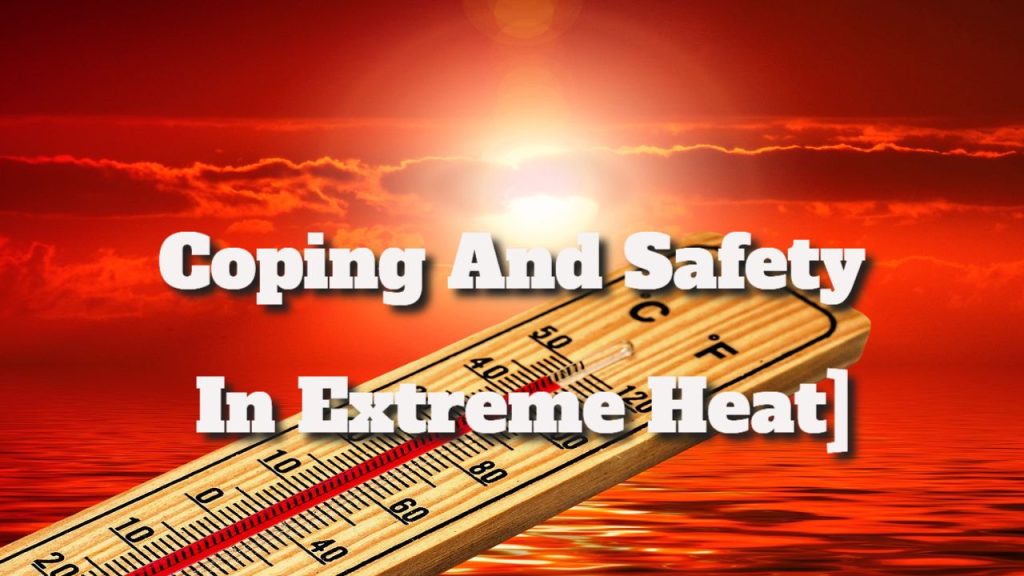Coping And Safety In Extreme Heat
Coping And Safety In Extreme Heat
The sensation of slowly dissolving under the hot heat is anything but pleasant. But don’t worry; there are ways to avoid the oppressive heat.
Summer’s hot embrace might be a terrible foe, but with the appropriate knowledge and some easy methods, you can stay calm and safe.
From recognising the subtle indicators of heat stroke to constructing a comfortable hideaway in your home, this conversation will provide you with the tools to navigate the hot season confidently.
Recognise the indications of heat stroke.
To detect heatstroke, pay close attention to how your body reacts to high heat and take fast action if symptoms arise. Heatstroke can be dangerous if not addressed right away.
Watch for signs including excessive perspiration, dizziness, rapid heartbeat, muscle cramps, and exhaustion. If you detect any of these symptoms, relax in a cooler area.
Consume plenty of fluids, ideally water, to rehydrate your body. Loosen any tight or constricting clothing and use cool, damp towels on your body to reduce body warmth. Avoid alcohol and caffeine, as they might worsen dehydration.
Seek immediate medical attention if symptoms continue or become worse. Recognising and responding to the signs of heat stroke is critical for avoiding significant problems.
Stay hydrated and prevent dehydration.
Stay hydrated to avoid dehydration, and drink plenty of fluids all day. To avoid significant health concerns in hot weather, keep your body hydrated.
When you sweat excessively, you lose water and electrolytes, which can cause dehydration. Consume plenty of water, sports drinks, or electrolyte-containing beverages to compensate for fluid loss. Avoid alcoholic and caffeinated beverages, as they might worsen dehydration.
Remember to drink even if you don’t feel thirsty because thirst is not always a reliable indicator of your body’s fluid requirements. To supplement your fluid intake, eat meals high in water, such as fruits and vegetables.
Seek shade and restrict outside activities.
Stay calm and avoid extreme heat by seeking cover and limiting outdoor activity.
Staying in covered regions is critical when the sun is blazing, and temperatures are rising. Look for trees, canopies, or umbrellas that provide some relief from the scorching heat.
Also, restrict your time outside during the hottest hours of the day, generally between 10 a.m. and 4 p.m. Instead, schedule your outdoor activities in the early morning or late afternoon when temps are more relaxed.
If you must remain outside during the hottest hours of the day, take regular pauses in shaded areas to cool down and hydrate.
Dress correctly, and use protective clothing.
It is critical to dress appropriately and employ protective equipment in extreme heat. Choose lightweight, loose-fitting clothing made from breathable materials like cotton or linen. Your body temperature is maintained by the free circulation of air made possible by these components.
Avoid dark colours, which absorb more heat. Instead, wear light-coloured clothing to reflect the sun’s beams. Wearing a hat with a wide brim will also help keep the sun off your neck and face. Sunglasses with UV protection are also vital for shielding your eyes from dangerous radiation.
Finally, apply sunscreen with high UV protection to all unprotected skin regions and reapply as needed. You can protect yourself from the dangers of extreme heat by wearing appropriate clothing and safety equipment.
Create a relaxed and comfortable interior temperature.
To stay comfortable in extreme heat, develop a cool interior temperature.
Begin by closing windows, blinds, and curtains during the day to block out the hot sun.
Use fans or air conditioners to distribute cool air throughout your home.
Place a bowl of ice before a fan to generate a temporary air conditioner.
Choose lightweight, breathable textiles for your mattress and apparel.
To alleviate what could be an overheating sensation, think about investing in a dehumidifier.
If you want to keep from being dehydrated, drink lots of water and cut off the alcoholic and caffeinated drinks.
Finally, reduce your use of heat-generating appliances like ovens and stoves and cook outside instead.
What are some common signs of heatstroke?
Common signs of heat stroke include:
Symptoms may include dizziness, nausea, headaches, and excessive perspiration.
Watch for these indications and take the necessary actions to protect yourself from extreme heat.
How much water should I drink to stay hydrated in extreme heat?
To maintain proper hydration in scorching weather, drink lots of water.
If you want to keep heat-related illnesses at bay, staying hydrated is vital.
Keep yourself hydrated all day long by sipping water.
Are certain times of day safer for outdoor activities in high heat?
In sweltering weather, you should avoid outside activities during the warmest part of the day.
Engaging in activities in the early morning or late evening is safer when temperatures are lower.
What kind of clothing is ideal to wear in high heat?
Wear loose, lightweight, light-coloured clothing to stay cool in the heat. Choose breathable textiles, such as cotton or linen.
For additional sun protection, remember to bring a wide-brimmed hat and sunglasses.
To keep your indoor environments cool without consuming a lot of energy:
– Close shades and drapes during the day. – Use fans or ceiling fans.
– Avoid using heat-generating gadgets like ovens.
Taking the essential precautions and prioritising your safety is critical during hot weather. Recognising the indications of heat stroke, staying hydrated, seeking shade, and wearing appropriate clothing are critical for dealing with high temperatures.
Furthermore, maintaining a cool and comfortable home atmosphere might assist in reducing the impacts of the heat. Keep yourself safe and healthy in hot weather by following these suggestions.
Stay safe!





